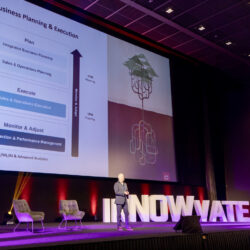Level five in S&OP is few and far between

Most companies starting with sales & operations planning (S&OP) get stuck at the third level out of a total of five. That is not a bad thing at all, said Sandeep Walia and Mike Donnely of software vendor Slimstock during Supply Chain Media’s Webinar Wednesday. “If the disadvantages outweigh the advantages, moving to level four or five is not a step forward, but rather a step backwards.”
By Marcel te Lindert
In Buddhism, nirvana represents the highest state that can be attained by humans, a state of enlightenment. Slimstock uses the term to refer to the fifth and highest level in Gartner’s S&OP maturity model. Companies that reach this level have a fully integrated S&OP process in which they collaborate with customers and suppliers to optimize profitability throughout the supply chain. This is also the level where companies – possibly using machine learning and other forms of artificial intelligence – are able to achieve all supply chain partners operating in complete harmony as one.
Pleased with level three
Few companies succeed in reaching this nirvana. Most get stuck at the first three levels. And that need not be a bad thing at all, claimed Walia and Donnely of Slimstock. “Very few companies advance to level four or five. Sometimes this is a conscious choice, because level three is sufficient to generate the value they envisage. And sometimes the step to level four or five is just too big. The costs simply do not outweigh the benefits,” explained Donnely, Head of Pre-sales at Slimstock UK.
“Level five is certainly not the holy grail everyone should strive for,” agreed Walia. “If you are happy with level three and the cost-benefit analysis for moving to level four is unfavourable, you should mainly stay at level three. If the disadvantages outweigh the advantages, moving to level four is not a step forward, but rather a step backwards,” emphasized Slimstock’s Chief Transformation Officer.
Mindset and scenario planning
The step to level four is a big one – not only in terms of investment and effort, but also mentally. Level four stands for collaboration with chain partners, and collaboration means sharing information. “I have a background in retail. That’s a sector where people often don’t want to collaborate because sharing information is risky. They are afraid of sharing secrets. Or that they share insights that end up being used against them,” Donnely said. “S&OP is not just a process, but a mindset that companies need to develop.”
In addition, companies need to work on scenario planning if they want to take the step to level four. Walia: “Level three is about forecasting products and sales. Level four is about planning for results. What is the impact on the operating result if a disruption occurs? This requires the ability to draw up, calculate and analyse scenarios. And to integrate digital twins into your planning process, for example.”
Mathematically linked planning
So what is needed for a functioning level three S&OP process? The companies that have it, according to Walia, share some common characteristics. The first characteristic is that they have mathematically linked schedules. “That means, for example, that a change in sales planning immediately leads to a change in procurement planning. If a company opens ten additional branches, it should be immediately visible what the impact is on the procurement of raw materials and packaging materials.”
Another feature is the use of cross-functional teams, in which tasks and roles are precisely defined. It should be clear which functions are involved and what contribution they make. “In addition, stability in operational planning is required. Many companies achieving success with S&OP handle production themselves or work with contract manufacturers to do so. Then it is necessary to have some stability upstream, even if volatility downstream is very high,” explained Walia. “Lastly, companies need to be able to analyse what causes it if the outcome deviates from plan.”
S&OP maturity assessment
At Slimstock, they describe implementing S&OP as a journey. The most important and difficult step on that journey is not the one from level three to level four, but the very first step. Donnely: “At the start, the organization often has disconnected management processes in which people are working in their own silos and are mainly fire-fighting. Maybe the people in all those silos don’t work against each other, but they certainly don’t work together in harmony. The realization that all these management processes are not integrated makes it clear that the company has a big problem to solve. Whatever level you are at, the fact that you have embarked on the S&OP journey is a big step in the right direction.”
For companies looking to accelerate their journey, Slimstock offers an S&OP maturity assessment. By asking people from different departments to answer 110 questions, companies can discover exactly where they are on the S&OP journey. “Often companies overestimate how far along they are. And often we see that one department is further along than another. Until we measure how far everyone is, we cannot manage progress. And if we can’t manage, we can’t improve,” Donnely stated. “Many companies focus on technology, but many S&OP projects fail precisely because of the behaviour of the people involved. If people are not ready for S&OP, the process is not going to work.”
Involvement of top management
In particular, the involvement of top management is crucial. Walia illustrated this with an example from his own career. “The CEO of the company where I worked at the time sent a memo to the management of all 60 divisions. It stated that a certain percentage of their annual bonus would now depend on the quality of the forecast and the inventory. This meant that suddenly the Chief Commercial Officer and the Chief Marketing Officer also had a direct interest in a well-functioning S&OP process. If a Chief Commercial Officer has no eye for inventory levels, he might meet sales targets, but not profit targets.”










